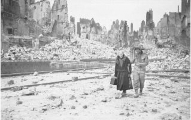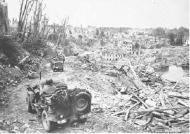The Bitter Road to Freedom: The Human Cost of Allied Victory in World War II Europe (6 page)
Read The Bitter Road to Freedom: The Human Cost of Allied Victory in World War II Europe Online
Authors: William I. Hitchcock

lien, took a direct hit: 54 people, including many of the church staff, were killed. Fires erupted across the city. “I feared that I would lose my mind in the face of such a calamity,” Poirier wrote. Another 250 names were add- ed that night to the lengthening rolls of the dead.
On the morning of July 9, Poirier noticed a new de- velopment: the few Germans still in the city were withdrawing. This was an organized retreat to higher ground south and east of the city; but for those Caen- nais in the northern quarter around Le Bon Sauveur, this marked the start of their liberation. In the after- noon, along the rue Guillaume le Conquérant, Poirier encountered a column of Canadian infantry—French Canadians—who handed out sweets and cigarettes to the bedraggled citizens of the quarter. In a gesture indicative of the continuity between pre-and postwar France that most local officials insisted upon, Poirier now withdrew from safekeeping his tricolored sash, the symbol of his municipal office, and put it on so as to be prepared to greet the British commanders. “I was overcome by emotion, for I recalled at this instant that on the morning of 18 June 1940, it was I that had the sad privilege of greeting the first German officer who arrived in Caen…. But today, the man who would soon present himself was our ally, one of the determined British who never lost faith in victory and who now re-
turned to us the right to wave our flag and to sing the Marseillaise.” Poirier greeted the commander of 201 Civil Affairs Detachment. They shook hands warmly, and Poirier acknowledged that they both had tears in their eyes. Yet the meeting took on a tragic-comic air when, after a long discussion about the desperate civilian needs in the city, the British major asked if Monsieur Poirier could suggest a good hotel where he might have a hot bath. Poirier, stunned, gathered his composure and gently informed the good major that there were virtually no buildings at all left standing in the city.
The liberation of the dead and ruined city of Caen now unfolded over the course of ten days. The British Sec- ond Army pushed up to the northern bank of the Orne, but then stopped, as the Germans had strategically redeployed in a fortified line to the south, on higher ground, and were able to shell, with perfect accuracy, the center of Caen. For the civilians in the northern half of the city, this was finally the time to evacuate, and Poirier, along with the wounded and refugees of the Bon Sauveur and other shelters, were transferred by the Anglo- Canadians to Bayeux and elsewhere in liberated territory. Not until July 18 did the British, deploying carpet bombing on the German positions to the east and south of the city, manage to push the
Germans out of Caen altogether. Again, the scale of the bombing was titanic: 2,100 aircraft from the RAF and
U.S. Eighth and Ninth Air Forces dropped more than eight thousand tons of bombs on the German lines, fol- lowing which British VIII Corps managed to push the stunned German defenders a few miles south. Though the Germans remained entrenched along the Bourgue- bus Ridge, from which they would not be dislodged un- til early August, the city of Caen was at last free. It was also a largely uninhabited, stinking, burning wreck. By the time the Canadians entered the northern part of the city on July 9, the survivors of Caen were unable to show a great deal of warmth for their liberators. Caen had “suffered an undeserved fate,” said one clergy- man.
30
“ The Canadian and British armies have been received in Caen without great enthusiasm,” wrote one of the Benedictine sisters of the Abbaye of Nôtre Dame de Bon Sauveur. “ The residents have been too shaken by the memory of days of agony and mourning which we have experienced, and by all the civilian dead, by all the grief. There was not on this day the joy that we might have had if these ‘friends’ had saved the women, the children, the old people. There has been too much suffering.”
31
* * *
C
AEN WAS THE largest city in Normandy to be destroyed, but dozens of smaller towns and vil- lages met a similar fate. Some were badly hit on
D-Day itself; others, like Falaise, would be chewed to pieces toward the end of the Normandy campaign as the Germans were slowly, brutally hammered during their retreat eastward. The extent of the destruction in Normandy profoundly shaped the way that soldiers— those sent to France to liberate civilians—came to un- derstand the war. It was impossible, after some of the things these men saw, to think about the war as “a great crusade,” as General Eisenhower had called it on D- Day; or to speak of killing Germans, as Monty had done on D-Day, as “good hunting.” Those soldiers who wrote diaries, letters, and memoirs—and thousands did so— uniformly avoided such clichés. The experience was simply too lugubrious for any but direct and accurate description.

“ Villers-Bocage was a sight I’ll never forget,” wrote one British trooper. “ There was just enough room for two lorries to pass through between two heaps of rubble which once were houses; the whole place was absolutely razed to the ground and just outside, in the fields, was a complete mass of bomb holes.” The once lovely town of Lisieux, home to a glorious cathedral and a site of many religious pilgrimages, was “abso- lutely flat, words can’t describe the destruction, Cov- entry and London are nothing compared with this.… If a bomb had been placed in every house the damage could not have been greater.”
32
Lisieux had suffered the second-highest death toll in Calvados after Caen: 781 killed. “ We traveled by jeep through Tilly-sur-
Seulles,” recalled another soldier, “now not so much a village as a scrap heap with every house and shop shattered.” The once well-tended land was filled with “orchard trees broken, blackened and stripped of foli- age, the ground blasted, buildings razed and carcasses of horses and cows lying in the open, grossly inflated, putrescent, and beset by swarms of blood-avid flies, feeding on their exposed flesh and tender parts.” In vil- lage after village, “roofs gape, houses lie in amorphous heaps and church spires, reduced to skeletal shapes, stand out like interrogation marks above surrounding debris. Streets are choked until bulldozers force a track through them, shoveling the rubble aside, temporarily blocking entrances to alleys and side streets.” Villers- Bocage “appeared dead, mutilated and smothered, a gigantic sightless rubble heap so confounded by dev- astation as to suggest an Apocalypse.” The small ham- let of Aunay-sur- Odon, where 145 people—9 percent of the population—had been killed by Allied bombing, had “no civilized shape,” and was “little more than a succession of crumpled ruins.”
33
Sgt. R. T. Greenwood saw only “a barren wilderness of destruction [that] resembles the battlefields of the last war. A few gaunt trees standing up, leafless, lifeless.”
34


11-18, 1944. U.S. National Archives
For sheer carnage, nothing matched the twenty-mile stretch of ground known as the Falaise pocket in which
the retreating Germans had been nearly encircled. Between Falaise and Argentan, the RAF’s murderous Typhoon fighter-bombers, with rocket projectiles and machine guns, had laid waste to the penned-in Ger- mans. The town of Falaise itself was churned into rub- ble: of 1,637 homes in the town, 950 were destroyed.
35
A few miles to the southeast, between Guêprei and Villedieu, K. W. Morris saw “the terrible results of the Allies’ saturation bombing and fierce fighting. The Ger- mans had suffered heavy casualties: thousands of pris- oners had been captured but many more lay dead in the fields, hedgerows, and woods.
Animals too had suffered. Cows, rigid and bloated, lay as they had fallen in the fields. Much of the German transport had been horse drawn. Dead horses still in their traces, sometimes with fearful injuries and intes- tines blown apart, blocked every road, the contents of their wagons strewn in the ditches. The stench of death was dreadful.”
36
Captain W. G. Caines passed through the same area where mass slaughters had taken place by Typhoon fighter bombers…. We traveled along one road and actually our vehicles traveled over the top of many hundreds of crushed German dead bodies and horses. Vehicles of all types of German transport lit- tered the whole area. I could never express here on this page or many others how that lot looked and stunk,
dead bodies were running over with maggots and flies, it was indeed a ghastly sight seeing these dead Nazis bursting in the blistering heat of the day. This road was about a mile and a half long, and never before had I smelled anything like it.
37
The nearby village of Chambois “stank of dead men and cattle,” recalled Lieutenant William Greene. “Our Typhoons and guns had wrought havoc all along the road which led through the smashed village…Ger- man dead were being buried. Stiffened corpses lay in the roadside fields, awaiting burial. Dead horses and cows cluttered up the farmyards. And down the road, unmoved by the carnage, three small girls wandered in their Sunday clothes. I thought of my own little girl at home and thanked God she had been spared this sight and experience.”
38
In this environment of devastating war damage and upheaval, soldiers tended to see civilians as simply an- other feature of a foreign, strange, and frequently bi- zarre world. In no sense did civilians put a human face on the events of liberation; on the contrary, the suf- ferings of civilians only made Normandy all the more inhuman and weird. In the midst of heavy shelling in the Falaise gap, A. G. Herbert recalled a surreal en- counter with two women, barefoot and dressed only in
nightclothes, their hair streaming in the wind as they ran. As they drew near I could see the leading woman was carrying a large picture of Christ in a frame still complete with glass. They were both hysterical, and clutched at my uniform, begging to know where to go out of the fighting. Although I spoke no French I was able to point out the way down and said “La Roguerie!” At that moment, a tank had made its way up the hill and was in the act of forcing a passage up the narrow track when it ran over a donkey which had followed the women down. The noise of the tank and the sight of the squashed donkey caused the women’s hysteria to rise to a new crescendo. They took to their heels, and in a moment were out of sight, running like the wind.
39
No less chilling was this scene near Falaise: “By the roadside, one small boy stood alone on a dead horse, flies from the carcass around his mouth, a national flag in his hand, stunned by the desolate scene.”
40
In Caen a few days after its liberation, “a few elderly women in funereal black moved around the debris, some ac- companied by children whose faces appeared equally ashen or dust grey.”
41
To these Allied soldiers, civilians were dirty, strange, and mostly unwelcoming. Roscoe Blunt of the U.S. 84th Infantry Division noted that in every bombed-out village he entered, the villagers were “suspicious, their faces sullen and silent.” Even
